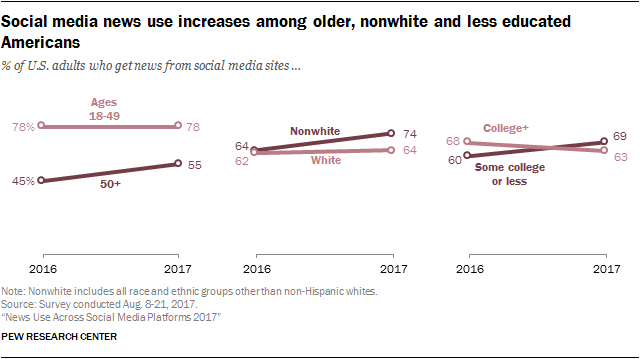 More Americans obtain their news through social media than ever and the figure continues to rise. According to the Pew Research Center, two-thirds (67 percent) of Americans say they get at least some of their news on social media and 20 percent do so often.
More Americans obtain their news through social media than ever and the figure continues to rise. According to the Pew Research Center, two-thirds (67 percent) of Americans say they get at least some of their news on social media and 20 percent do so often.
Social media news consumption increased since early 2016 when 62 percent of U.S. adults said they consume news through social media. Most notably, more Americans who are older, less educated and nonwhite obtain news on social media, reveals the Pew survey done last month. For the first time, more than half (55 percent) of Americans ages 50 or older report they consume news on social media sites, a 10 percentage point increase from last year.
Most (78 percent) of those under 50 are more likely to get their news through social media. About three-quarters of nonwhites (74 percent) get news on social media sites, up from 64 percent in 2016. Social media news use also increased among those with less than a bachelor’s degree. Among those with at least a college degree, social media news use declined slightly.
The takeaway: Social media news consumption is no longer confined to the young or internet savvy. It’s more essential than ever for corporate PR and marketing to promote and monitor news on social media.
Most Popular Networks for News Consumption
Facebook is the leading news source on social media, due to its large user base. Almost half (45 percent) of Americans get news through Facebook. YouTube is the second most popular social media site for news consumption: 18 percent of Americans now get news there. While YouTube has a large user base with 58 percent of the population, a smaller portion of viewers gets news there. In 2017, both its user base and number of people who view news increased. It launched and expanded YouTube TV, and the site added a “breaking news” summary on its homepage. It remains a key venue for disseminating information to small, dispersed communities.
The share of Twitter users consuming news on that network increased to three-quarters (74 percent), up 15 percentage points from last year. President Trump’s constant tweeting focused attention on the network, and Twitter pursued news partnerships over the past year to bolster its strengths in news consumption. Because of Twitter’s smaller user base, fewer Americans — just 11 percent of U.S. adults — obtain news on the network.
The takeaway: Twitter draws substantial attention from the news media and PR pros, often due to Trump’s controversial tweets. But PR teams ignore other networks at their own peril. In particular, brands may wish to consider YouTube as a PR and marketing channel.
Demographic Differences of Different Networks
The demographic composition of each site’s news users vary substantially. Instagram and Snapchat news consumers are considerably more likely to be nonwhite and younger. Twitter and LinkedIn have the largest share of college graduates. Older Americans tend to prefer Facebook and YouTube. Snapchat has by far the youngest group of news users.
The takeaway: Understanding demographic of various social platforms can help brands target their PR and marketing efforts. While media monitoring of different networks for brand networks is vital, few organizations have the resources for robust marketing campaigns across all networks.
What About Traditional Media?
People who get their news on social media also get news through traditional channels. There are noticeable differences between platforms. Facebook news users are more likely to often obtain news from local TV.
The takeaway: Social media isn’t everything. Wise PR teams monitor television and traditional media outlets and still emphasize traditional media to publicize their organizations.
Bottom Line: Younger people are more likely to find their news on social media than directly from conventional news media. And now older Americans are embracing social media news consumption. The trends highlight the importance of social media monitoring, measurement and marketing.
William J. Comcowich founded and served as CEO of CyberAlert LLC, the predecessor of Glean.info. He is currently serving as Interim CEO and member of the Board of Directors. Glean.info provides customized media monitoring, media measurement and analytics solutions across all types of traditional and social media.





